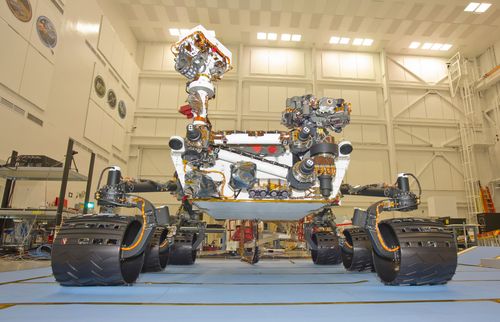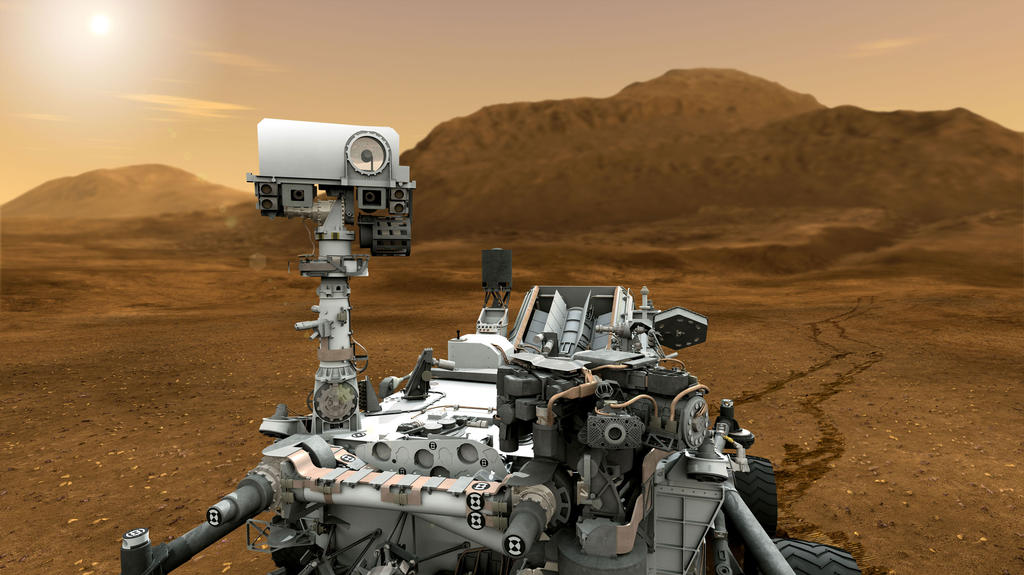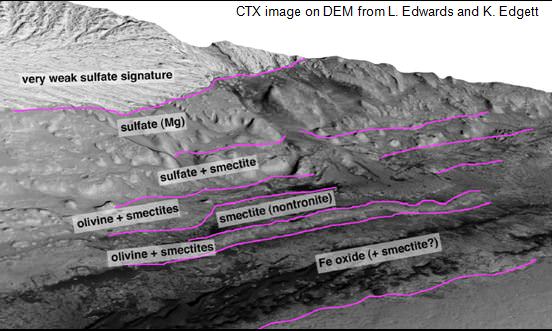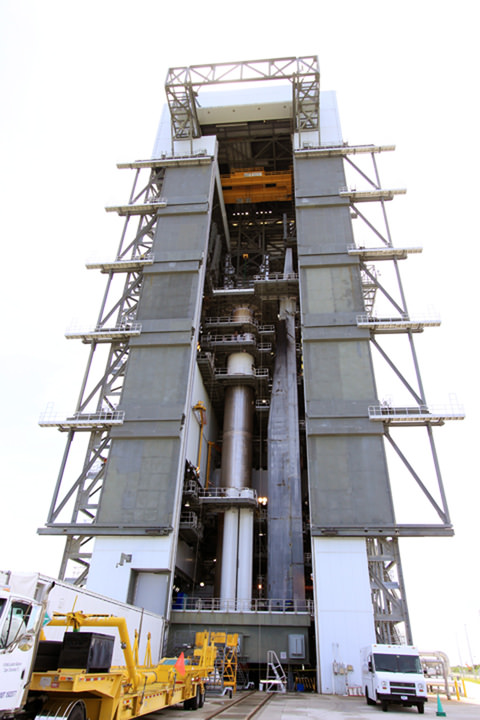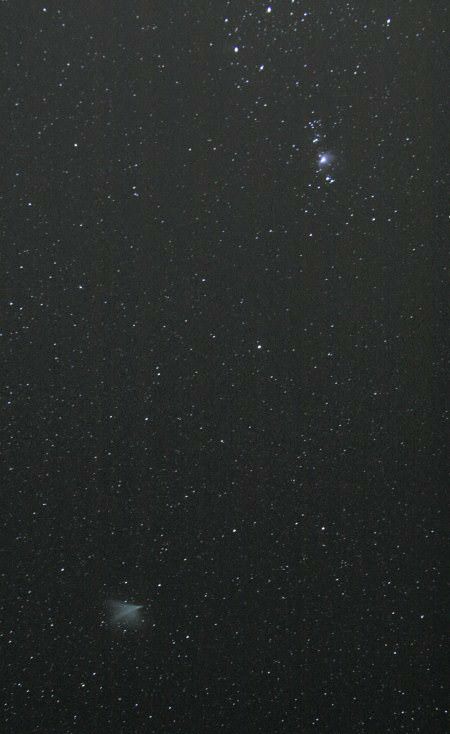Re: Curiosity: Mars Science Laboratory
Posted: Thu Jun 02, 2011 7:42 am
Camera Duo On Mars Rover Mast Will Shoot Color Views | 2011 May 31
Mast Camera View of Curiosity's Deck
The left eye of the two-camera Mast Camera (Mastcam) instrument on NASA's Mars rover Curiosity took the images combined into this mosaic of the rover's upper deck. The images were taken in March 2011. At the time, Curiosity was inside a space simulation chamber at NASA's Jet Propulsion Laboratory, Pasadena, Calif., for testing under thermal conditions like those the rover will experience on the surface of Mars.
Mastcam's left eye, Mastcam 34, has a 34-millimeter focal length lens providing a medium field of view. The instrument's right eye, Mastcam 100, has a 100-millimeter telephoto lens. Malin Space Science Systems, San Diego, built the instrument and two other cameras on Curiosity.
The front of the rover is toward the right in this image. On the left is the outer cover for the mission's nuclear power source, a radioisotope thermoelectric generator. At far right is the turret a the end of Curiosity's robotic arm. The light-colored hexagonal object in the top left quadrant of the mosaic is the high-gain antenna, which is about 10 inches (25 centimeters) across. Two digital color cameras riding high on the mast of NASA's next Mars rover will complement each other in showing the surface of Mars in exquisite detail.
They are the left and right eyes of the Mast Camera, or Mastcam, instrument on the Curiosity rover of NASA's Mars Science Laboratory mission, launching in late 2011.
The right-eye Mastcam looks through a telephoto lens, revealing details near or far with about three-fold better resolution than any previous landscape-viewing camera on the surface of Mars. The left-eye Mastcam provides broader context through a medium-angle lens. Each can acquire thousands of full-color images and store them in an eight-gigabyte flash memory. Both cameras are also capable of recording high-definition video at about eight frames per second. Combining information from the two eyes can yield 3-D views of the telephoto part of the scene.
Motivation to put telephoto capability in Curiosity's main science imaging instrument grew from experience with NASA's Mars Exploration Rover Opportunity and its studies of an arena-size crater in 2004. The science camera on that rover's mast, which can see details comparably to what a human eye can see at the same distance, showed intriguing patterns in the layers of Burns Cliff inside Endurance Crater.
"We tried to get over and study it, but the rover could not negotiate the steep slope," recalled Mastcam Principal Investigator Michael Malin, of Malin Space Science Systems, San Diego. "We all desperately coveted a telephoto lens." NASA selected his Mastcam proposal later that year for the Mars Science Laboratory rover.
The telephoto Mastcam, called "Mastcam 100" for its 100-millimeter focal-length lens, provides enough resolution to distinguish a basketball from a football at a distance of seven football fields, or to read "ONE CENT" on a penny on the ground beside the rover. Its images cover an area about six degrees wide by five degrees tall.
Its left-eye partner, called "Mastcam 34" for its 34-millimeter lens, catches a scene three times wider -- about 18 degrees wide and 15 degrees tall -- with each exposure.
Researchers will use the Mastcams and nine other science instruments on Curiosity to study past and present environments in a carefully chosen area of Mars. They will assess whether conditions have been favorable for life and favorable for preserving evidence about whether life has existed there. Mastcam imaging of the shapes and colors of landscapes, rocks and soils will provide clues about the history of environmental processes that have formed them and modified them over time. Images and videos of the sky will document contemporary processes, such as movement of clouds and dust.
Previous color cameras on Mars have taken a sequence of exposures through different color filters to be combined on Earth into color views. The Mastcams record color the same way consumer digital cameras do: They have a grid of tiny red, green and blue squares (a "Bayer pattern" filter) fitted over the electronic light detector (the charge-coupled device, or CCD). This allows the Mastcams to get the three color components over the entire scene in a single exposure.
Mastcam's color-calibration target on the rover deck includes magnets to keep the highly magnetic Martian dust from accumulating on portions of color chips and white-gray-balance reference chips. Natural lighting on Mars tends to be redder than on Earth due to dust in Mars' atmosphere. "True color" images can be produced that incorporate that lighting effect -- comparable to the greenish look of color-film images taken under fluorescent lights on Earth without a white-balancing adjustment. A white-balance calculation can yield a more natural look by adjusting for the tint of the lighting, as the human eye tends to do and digital cameras can do. The Mastcams are capable of producing both true-color and white-balanced images.
Besides the affixed red-green-blue filter grid, the Mastcams have wheels of other filters that can be rotated into place between the lens and the CCD. These include science spectral filters for examining the ground or sky in narrow bands of visible-light or near-infrared wavelengths. One filter on each camera allows it to look directly at the sun to measure the amount of dust in the atmosphere, a key part of Mars' weather.
"Something we're likely to do frequently is to look at rocks and features with the Mastcam 34 red-green-blue filter, and if we see something of interest, follow that up with the Mastcam 34 and Mastcam 100 science spectral filters," Malin said. "We can use the red-green-blue data for quick reconnaissance and the science filters for target selection."
When Curiosity drives to a new location, Mastcam 34 can record a full-color, full-circle panorama about 60 degrees tall by taking 150 images in about 25 minutes. Using Mastcam 100, the team will be able to broaden the swath of terrain evaluated on either side of the path Curiosity drives, compared to what has been possible with earlier Mars rovers. That will help with selection of the most interesting targets to approach for analysis by Curiosity's other instruments and will provide additional geological context for interpreting data about the chosen targets.
The Mastcams will provide still images and video to study motions of the rover -- both for science, such as seeing how soils interact with wheels, and for engineering, such as aiding in use of the robotic arm. In other videos, the team may use cinematic techniques such as panning across a scene and using the rover's movement for "dolly" shots.
Each of the two-megapixel Mastcams can take and store thousands of images, though the amount received on Earth each day will depend on how the science team chooses priorities for the day's available data-transmission volume. Malin anticipates frequent use of Mastcam "thumbnail" frames -- compressed roughly 150-by-150-pixel versions of each image -- as an index of the full-scale images held in the onboard memory.
Malin Space Science Systems built the Mastcam instrument and will operate it. The company's founder, Michael Malin, participated in NASA's Viking missions to Mars in the 1970s, provided the Mars Orbiter Camera for NASA's Mars Global Surveyor mission, and is the principal investigator for both the Context Camera and the Mars Color Imager on NASA's Mars Reconnaissance Orbiter.
The science team for Mastcam and two other instruments the same company provided for Curiosity includes the lead scientist for the mast-mounted science cameras on Mars rovers Spirit and Opportunity (James Bell of Arizona State University); the lead scientist for the mast camera on NASA's Phoenix Mars Lander (Mark Lemmon of Texas A&M University); James Cameron, director of such popular movies as “Titanic” and “Avatar”; and 17 others with expertise in geology, soils, frost, atmosphere, imaging and other topics.
Mastcam 100 and Mastcam 34 were installed onto Curiosity in 2010. Until March 2011, a possibility remained open that they might be replaced with a different design: two identical zoom cameras. A zoom camera has adjustable focal length, to change from wider-angle to telephoto or vice-versa. That design had been Malin's original proposal. NASA changed the plan to two different fixed-focal-length cameras in 2007 as a cost-cutting measure that preserves the capability for meeting the science goals of the mission and the instrument. The agency funded a renewed possibility for using the zoom-camera design in 2010, but the zoom development presented challenges that could not be fully overcome with enough time for required testing on the rover.
Mastcam 34 took images for a mosaic showing Curiosity's upper deck during tests in March 2011 inside a chamber simulating Mars surface temperature and air pressure. Testing of the rover at NASA's Jet Propulsion Laboratory, Pasadena, Calif., will wrap up in time for shipping the rover to NASA Kennedy Space Center in June. Testing and other launch preparations will continue there. The launch period for the Mars Science Laboratory is Nov. 25 to Dec. 18, 2011, with landing on Mars in August 2012.

